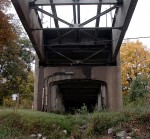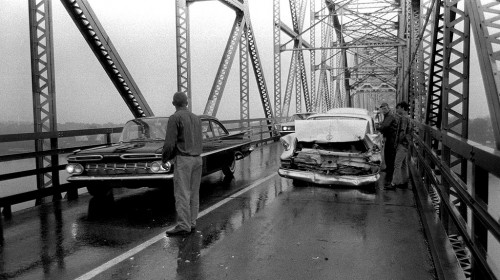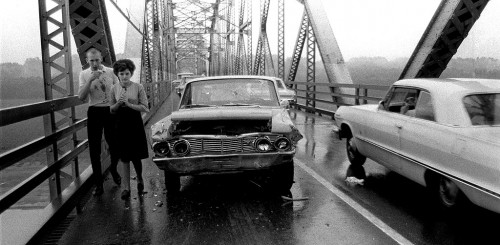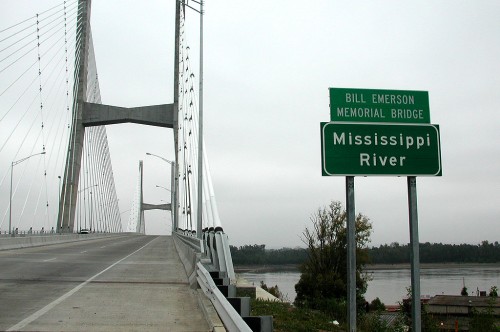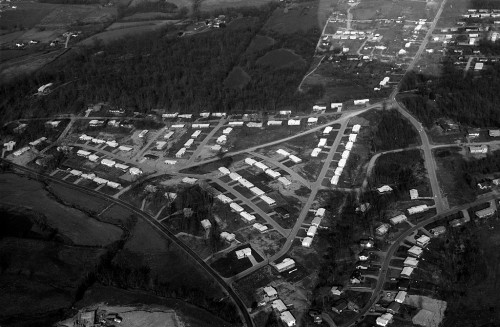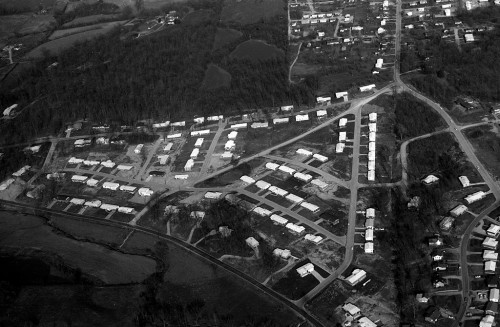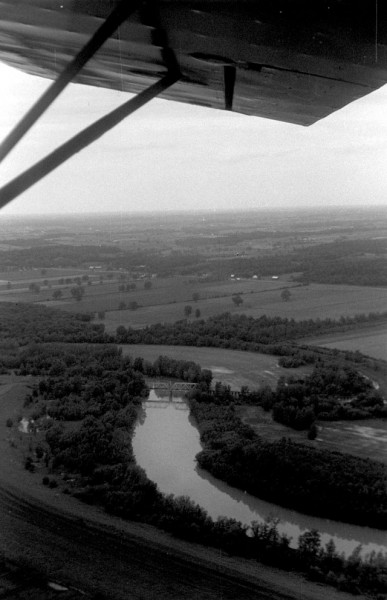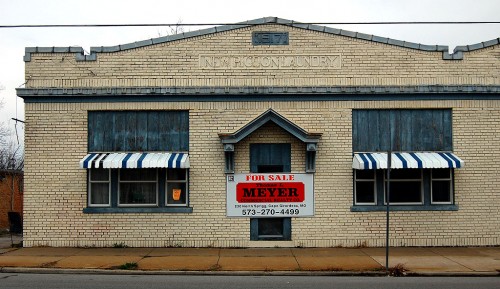 I always wondered why the building with 1917 on it was called the “New Rigdon Laundry,” when the building next to it was dated 1931.
I always wondered why the building with 1917 on it was called the “New Rigdon Laundry,” when the building next to it was dated 1931.
There was a logical explanation for it. The original Rigdon Laundry was on South West End Blvd. When it moved to South Sprigg Street in 1917, it became the “New” Rigdon Laundry. (The “Old” Rigdon Laundry was turned into a canning center in 1934.)
The New Rigdon Laundry might have done dry cleaning, but its history was anything BUT dry. If you don’t believe me, skip down to the bottom and read the murder mystery involving one of its drivers.
New Rigdon Laundry has long history
Here are just a few of the stories that appeared in The Missourian over the years:
- July 11, 1916 – J.A. Rigdon says he will start constructing model laundry building on Sprigg St. between Independence and Themis streets sometime in September; Rigdon purchased lot 45 feet by 180 feet on Sprigg St. across from Negro Masonic hall; building he will erect will be about 45 by 120 feet, and wagon sheds, coal houses and storage rooms will be built behind it.
- Dec. 4, 1919 – Coal Shortage Is Being Felt in Cape Girardeau: The city is just beginning to be really effected by the coal situation and to curtail its activities. the Centennary (sic) church which for a while quit having moving picture shows will resume this once more as they have enough wood to run them for quite a while. The New Rigdon Laundry though yesterday that it would be necessary for it to close down, but Al Salzgeber, proprietor of the Idan-Ha Hotel came to the rescue and let it have some coal, enough for two days. Mr. Rigdon then obtained some coal from the West End Fuel Company, enough to run them the rest of the week and about two days of the next.
Edna Hilpert gets toe crushed
- Feb. 8, 1921 – Edna Hilpert had about half an inch of her big toe crushed off when her right foot was caught in a cog of one of the motors.
- Apr. 12, 1924 – New Rigdon Laundry gets new rug cleaning machine, the first of its kind between St. Louis and Memphis. Cleaning the average rug costs less than $3.50.
- June 26, 1926 – Completed installation of The Thermo-Vento Drying Machine. The operation of this modern laundry dryer is a marvel to watch. It handles six full family washes and the clothes literally float in the air as they go through the process of drying. It only takes 15 minutes to dry the batch of six family washes.
- Feb. 9, 1931 – Construction will begin tomorrow on a new laundry plant at 18-22 N. Sprigg St. in Cape Girardeau, to be erected by J.A. Rigdon, owner of the New Rigdon Laundry; the new plant, to be built adjacent to the present plant on the south, will practically double the size of the laundry.
Lions color 5,000 Easter eggs
- Mar. 23, 1932 – The Lions played Easter rabbits…and prepared about 5,000 prettily colored eggs for the Annual Easter Egg Hunt… Starting the job of boiling and coloring eggs about 7:30 Tuesday evening, they worked until 10 o’clock, at which time nearly 14 cases of eggs were finished for the big event. Less than 20 members of the club did the job, owing to the fine engineering ability of Harold Hebbeler and Charles Rigdon. The boiling and coloring was done in the basement of the Rigdon Laundry, which was tendered the club for the work by Mr. Rigdon.
- Feb. 12, 1934 – Purchase of the Cape Laundry Co. equipment and real estate at 45 S. West End Blvd. by the New Rigdon Laundry, 22 N. Sprigg St., is announced by J.A. Rigdon; the deal involved cash and real estate, including five houses, in addition to the equipment and real estate.
New Rigdon Laundry get bigger boiler
- Aug. 16, 1934 – A boiler room extension is being constructed at the New Rigdon Laundry, 22 N. Sprigg St.; the brick addition will be 10 feet wide and 5 feet long, and enlarges the present boiler room so that a larger boiler can be installed.
- Nov. 22, 1932 – New Rigdon Laundry and Dry Cleaning plant, 16-22 North Sprigg St., is model of modern cleaning methods; history of plant can be traced to J.A. Rigdon, who set up laundry business in St. Genevieve in 1898; he purchased Cape Girardeau steam laundry in 1915, which was destroyed by fire a year later. In 1917, he erected New Rigdon Laundry and has since made it a model of efficiency.
Bill Tipton buys Rigdon Laundry
- April 19, 1954 – Sale of equipment of Rigdon Laundry, 23 N. Sprigg, to Tipton’s Whiteline Laundry Inc., is announced jointly by Mr. and Mrs. Thomas O. McGee of Rigdon Laundry and Bill Tipton, president and manager of Whiteline.
- May 6, 1958 – Another familiar sight to local residents — the smoke that has risen for some 40 years from the chimney on the Rigdon Laundry building — is gone; the old, hand-fired coal boiler, which has been in use since around 1917, has been replaced by a modern gas boiler as part of a remodeling program by owner Bill W. Tipton.
- July 28, 1974 – Mr. and Mrs. Bill Tipton, owners and operators of Rigdon’s Laundry, and the dry cleaning and linen services which are a part of the business, have announced purchase of a building at 1415 Independence St…. The firm has been in present location for 20 years. The Tiptons purchased the business in April 1954. It was established by the Rigdon family, later acquired by Mr. and Mrs. Thomas McGee. Mrs. McGee still owns the structure.
Laundry driver found shot dead
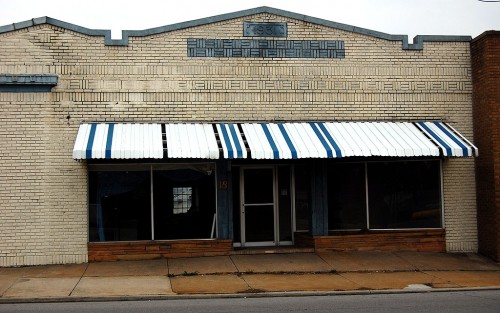 Big news in The Missourian Aug. 14, 1926: Evidently shot from ambush, the murdered body of Robert Deevers was found Friday afternoon on Jackson Hill, on the road from Illmo to Commerce. Deevers, a truck driver for the New Rigdon Laundry, was found lying on his back, 20 feet away from his truck, an automatic pistol six feet away from his body. Two bullets, thought to be .32 or .38 caliber, had taken effect, one in his biceps of his left arm and the other in his chest, ranging from his right side down through the lower part of his heart and out of his left side.
Big news in The Missourian Aug. 14, 1926: Evidently shot from ambush, the murdered body of Robert Deevers was found Friday afternoon on Jackson Hill, on the road from Illmo to Commerce. Deevers, a truck driver for the New Rigdon Laundry, was found lying on his back, 20 feet away from his truck, an automatic pistol six feet away from his body. Two bullets, thought to be .32 or .38 caliber, had taken effect, one in his biceps of his left arm and the other in his chest, ranging from his right side down through the lower part of his heart and out of his left side.
Follow this link to read the whole story, including a sidebar about how the victim was quoted as saying, “Well, if a hold-up gets me, he’ll have to be a better man than I am. And, besides, you know I don’t put much stock in most of these robberies. I think they’re just framed up and the fellow who was robbed know just when and where it’s going to happen. Then he gets his share.”
Dead driver bought life insurance policy
A follow-up story Aug. 24, 1926, said that the driver, who had been shot to death by unknown assassins had taken out a $6,000 life insurance policy Aug. 9; he was fatally wounded Aug. 13. Follow this link to read how the authorities thought the insurance policy was an indication that the driver feared what the future might bring and desired to care for his family in the event something happened to him. Sheriff E.A. Dye characterized the case as almost “hopeless” because there were few clews at the scene of the murder.”
Driver not murdered; shot himself
After the sheriff had pretty much given up hope of solving the shooting death, an investigator from the Burns Detective Agency came up with a theory that the driver killed himself “while morose over recent gambling losses and an increasing debt owed the New Rigdon Laundry.”
It’s worth following the link the the Sept. 13, 1926, Missourian to read the whole investigation. The crime scene analysis reads like something you’d see on a TV whodunit these days. The sheriff and the prosecuting attorney closed the probe and ruled the death a suicide.
 The old Cape Mississippi River Traffic Bridge was an adolescent adrenaline rush, a white-knuckled journey of fear and angst; it was an inconvenience, it was the site of personal and family tragedy. It also opened up Cape Girardeau to Illinois and points east when it became the first bridge across the Mississippi River between St. Louis and Memphis.
The old Cape Mississippi River Traffic Bridge was an adolescent adrenaline rush, a white-knuckled journey of fear and angst; it was an inconvenience, it was the site of personal and family tragedy. It also opened up Cape Girardeau to Illinois and points east when it became the first bridge across the Mississippi River between St. Louis and Memphis.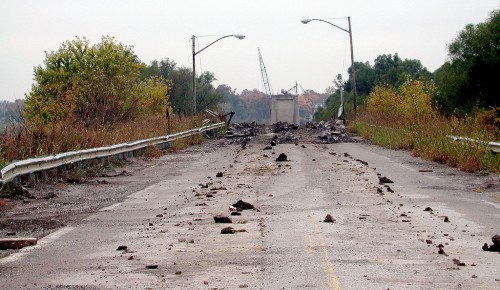 The steelwork has all been removed, but they were still working on removing the bridge piers when I shot this photo from the Illinois side of the river in October of 2004.
The steelwork has all been removed, but they were still working on removing the bridge piers when I shot this photo from the Illinois side of the river in October of 2004. The massive piers that held the bridge up were the last parts to be demolished. This photo shows the flood gates that are closed, blocking north and south rail traffic when the river gets high. I prowled around under the bridge here and picked up a few souvenir pieces of steel. The Missourian said 160,000 rivets were used in building the bridge.
The massive piers that held the bridge up were the last parts to be demolished. This photo shows the flood gates that are closed, blocking north and south rail traffic when the river gets high. I prowled around under the bridge here and picked up a few souvenir pieces of steel. The Missourian said 160,000 rivets were used in building the bridge.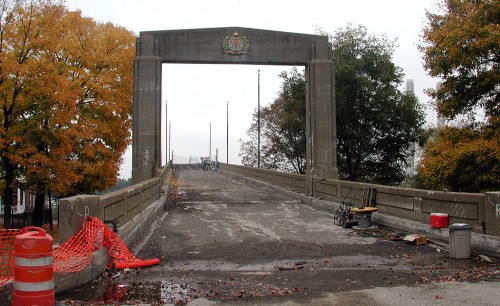 The decorative archway over the Cape approach to the bridge has been preserved and a portion of the span has been turned into an attractive viewing area. I wish that the whole bridge could have been preserved for bicycles and pedestrians like the Chain of Rocks Bridge north of St. Louis, but the Coast Guard considered having two bridges that close together to be a navigation hazard.
The decorative archway over the Cape approach to the bridge has been preserved and a portion of the span has been turned into an attractive viewing area. I wish that the whole bridge could have been preserved for bicycles and pedestrians like the Chain of Rocks Bridge north of St. Louis, but the Coast Guard considered having two bridges that close together to be a navigation hazard.












